|
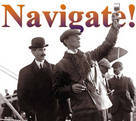
 Up
Up 
Return To
Kitty Hawk 
 The Virtual
The Virtual
Hangar 
(You are here.)
 Down
Down

The
1903
Wright
Flyer I

The
1905
Wright
Flyer III




  Need
to Need
to
find your
bearings?
Try
these
navigation aids:
If this
is your first
visit, please stop by:
Something
to share?
Please:



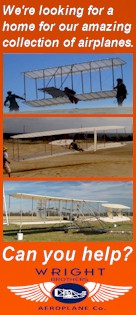 |
|
Available in Française, Español, Português, Deutsch, Россию,
中文,
日本, and others.
 right
airplanes are elegant machines that hold the same fascination as
tall ships, steam locomotives, and vintage automobiles. And it's not
just because they are old or quaint. They are the essence of flying -- a
set of wings, an engine, propellers, and a place to sit. Their design is
entirely functional, there is no ornament, not a part that does not have a
purpose. Yet, for all that function, they have a striking and exciting
appearance. If adventure were a solid thing, this is the form it would take. right
airplanes are elegant machines that hold the same fascination as
tall ships, steam locomotives, and vintage automobiles. And it's not
just because they are old or quaint. They are the essence of flying -- a
set of wings, an engine, propellers, and a place to sit. Their design is
entirely functional, there is no ornament, not a part that does not have a
purpose. Yet, for all that function, they have a striking and exciting
appearance. If adventure were a solid thing, this is the form it would take.
It's no surprise that some of our members with a craftsman's
appreciation for a fine machine have built replicas of these pioneer aircraft.
Presently, we have completed ten Wright aircraft – six to study in flight,
two for display, and two we helped students to build. Most of these flying machines are designed for over-the-road travel
so they can reach
the widest possible audience. Some are part of our "portable
museum" that we tour to schools and libraries -- the
Secret
of Flight
Project. Others are available for
museums and exhibitions.
All of the aircraft we have built so far are replicas of the
Wright's "experimental" kites, glider, and Flyers – the aircraft the
Wrights built between 1899 and 1905 in their quest for a practical
flying machine. We have collected pictures of our replicas here so
you can do virtual "walk-around."
|
|
The 1899 Wright
Kite was the Wright brothers first aeronautical experiment. It
wasn't a really a kite, but a miniature glider designed to test an
aerodynamic control system. Wilbur Wright devised a system to twist or
"warp" the biplane wings of the model glider, causing one wing tip to
turn up while the other turned down. This caused the wings to develop
more lift on one side and less lift on the other, rolling the aircraft.
This flying reproduction was featured in the PBS documentary Kitty
Hawk: A Journey of Invention. It is one of the artifacts in our
"portable museum" that tours with our
Secret of
Flight Project.
|
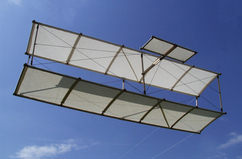
1899 Wright Kite.
|
The
1900 Wright Glider was the Wright brother's first
man-carrying aircraft, and first in which they made free flights. It did
not produce enough lift to fly much more than a few hundred feet,
nonetheless it gave the brothers a taste of what it was like to fly. The
glider had aerodynamics controls for roll (wing warping)and pitch (a
forward elevator). Early on the aircraft had a stationary tail with
vertical and horizontal fins, but this was discarded after a few tests.
This replica was flown at Jockey's Ridge State Park, North
Carolina on October 22, 2000 to mark the centennial anniversary of the
Wright's first gliding flights. It was also featured in the documentary
Kitty Hawk: A Journey of Invention.
|
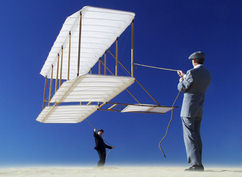
1900 Wright Glider.
|
The
1901 Wright Glider was the Wright brother's second attempt
to build a
man-carrying aircraft, and first in which they tried to make a turn in the
air by rolling the aircraft. It was much larger the 1900 glider before
it, but still did not produce the predicted amount of lift. Furthermore,
their aerodynamic controls were less effective than on their previous
machine. These multiple problems very nearly convinced the Wright
brothers to abandon aeronautics. This replica flew at Jockey's Ridge
State Park, North
Carolina on September 9 to mark the centennial anniversary of the
Wright's 1901 gliding experiments. It was also featured in the documentary
Kitty Hawk: A Journey of Invention.
|
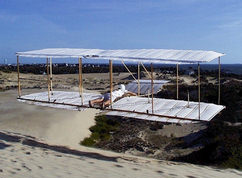
1901 Wright Glider.
|
The 1901 Wright
Wind Tunnel, along with its balances, was the scientific
instrument the Wright brothers built to help design an aircraft capable
of lifting itself and a pilot off the ground. You don't necessarily
expect to find a wind tunnel in a hangar – even a virtual hangar – but
this machine was crucial to the Wright brothers' eventual success. It
was this machine that allowed them to compare the shape and camber of
hundreds of wings and pick the best one for their purposes. For that
reason it was also crucial to our archaeological investigation. We built
a replica tunnel, then conducted the same tests as the Wrights. Like
many of the machines in our hangar, this tunnel was featured in the
documentary Kitty Hawk: A Journey of Invention. It is also one of
the artifacts in our portable museum that tours with our
Secret of
Flight Project.
|
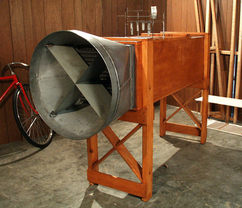
1901 Wright Wind Tunnel.
|
|
The 1902 Wright
Glider was the first fully controllable aircraft, with
aerodynamic control
surfaces for 3-axis control – wing-warping for roll, an elevator for
pitch, and a rudder for yaw.. It was also the aircraft on which the
Wrights based their patent. Every successful aircraft made
since can trace its roots back to this machine. This reproduction
was flown on by test pilots from the US Air Force, US Navy, and US
Army at Jockey's Ridge State Park, North Carolina to celebrate the
Centennial of Controlled Flight on October 8, 2002. We have flown it
many times since then, including for the documentary Kitty Hawk:
A Journey of Invention. Another 1902 glider replica, built and
flown by young men and women from Russia, Ohio is the centerpiece of
our
Secret of Flight Project.
|
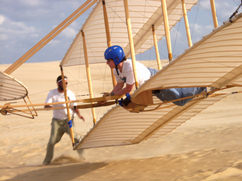
1902 Wright Glider.
|
The 1903 Wright
Flyer I
became the first aircraft to successfully make sustained, controlled
powered flights on December 17, 1903. On that date, the Wrights made
four flights, the longest lasting 59 seconds and covering 852 feet
(260 meters). After the last flight it was wrecked by a gust of wind
and never flew again. We attempted to fly our replica in 2003 and
2004 in both North Carolina and Ohio. On January 7, 2004 we
successfully repeated the first flights of the Wright brothers and
Connie Tobias, a veteran pilot from US Airways, became the first
woman to successfully fly the 1903 Wright Flyer. This aircraft was
also featured in the documentary Kitty Hawk: A Journey of
Invention.
|
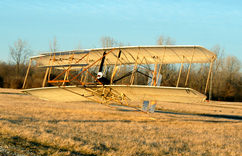
1903 Wright Flyer I.
|
|
The 1905 Wright
Flyer III was the first "practical" airplane – an
airplane that could take off in a wide range of weather
environments, navigate to a predetermined location, and land
"without crashing," as Wilbur so succinctly put it. It was also the
first airplane with independent controls for each axis. In the 1902
glider and the 1903 Flyer, the Wright brothers had "coupled" the
wind-warping with the rudder so that both were activated by the same
control. In the Flyer III, the rudder and the elevator had separate
controls which aided the pilot's ability to maneuver the airplane.
Our replica includes a reproduction of the Wright catapult, a wooden
tower that drops a substantial weight to provide extra thrust to the
aircraft during its launch.
|
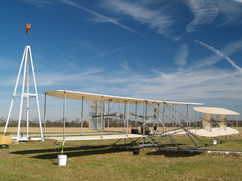
1903 Wright Flyer III.
|
Something
Missing?
Why don't we include the 1904 Wright Flyer II in this
line-up? For the simple reason that the Flyer II was a
copy of the Flyer I. The Flyer I made only four
flights at Kitty Hawk before a gust of wind rolled the aircraft and
destroyed it. When they arrived back in Dayton in 1903, the Wright
brothers realized that they hadn't thoroughly tested their airplane
and hadn't learned enough about it to build a better one. So they
rebuilt the design in 1904 and proceeded with test flights.
There
were a very few changes on the Flyer II. When the first Flyer
rolled, the Wrights discovered how fragile the ribs were -- every
single one broke! So they simplified the rib design to make them
stronger and slightly altered the camber from 1:20 to 1:24. They
also beefed up the frame of aircraft, particularly the skids, to
make it stronger. This made the airplane heavier. Finally, they
built a new engine and added an oil pump. There may have also been
further improvements to the engine to help it produce more power and
run cooler. But all these were minor tweaks. Visually and
aerodynamically, the second Flyer was the twin of the first one.
|
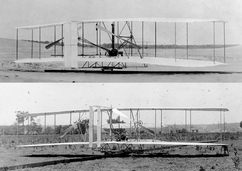
The 1903 Wright Flyer I (top) and the 1904 Wright Flyer II (bottom),
photographed from nearly the same angle.
|
|
|
|

